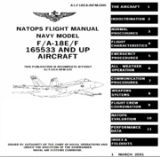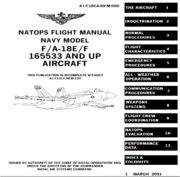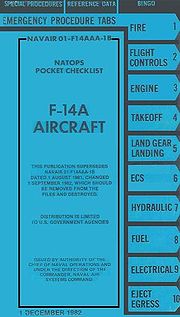
NATOPS
Encyclopedia
The Naval Air Training and Operating Procedures Standardization (NATOPS) program prescribes general flight and operating instructions and procedures applicable to the operation of all US naval aircraft and related activities. The program issues policy and procedural guidance of the Chief of Naval Operations
(CNO) that is applicable to all Navy and Marine Corps
aviation personnel.
Each NATOPS manual has the following statement:
in 1961 as a positive approach towards improving combat readiness and achieving a substantial reduction in naval aircraft mishaps.
In 1950 the US Navy/Marine Corps lost 776 aircraft (roughly 2 airplanes per day or a rate of 54 major mishaps per 10,000 flight hours).
Numerous technical initiatives, including the angled flight deck
in 1954, and standardization programs, were credited with significantly reducing the rate to 19 major mishaps per 10,000 flight hours by 1961, and further to 9 by 1970 (the current rate, for comparison, is under 2 major mishaps per 10,000 flight hours).
A lack of standardization and training in both maintenance and flight operations was cited as causal in a large percentage of mishaps. Several standardization programs were initiated in the late 50’s and early 60’s to counter this problem. The first was the Naval Aviation Maintenance Program (NAMP) in 1959. Prior to the NAMP, aircraft maintenance practices were completely non-standardized. For example, an aircraft maintenance procedure might be significantly different from one squadron to the next. The NAMP standardized maintenance procedures across the entire Naval Aviation enterprise.
The second standardization initiative began in 1961 with the introduction of the Fleet Replacement Squadron
(FRS) program. FRSs indoctrinate newly designated aircrew and aircraft mechanics into the peculiarities of specific aircraft. Prior to the FRS concept, qualified pilots transitioning to a new aircraft were essentially told how to start it, and then sent to go fly. The final major standardization program put in place was NATOPS in 1961.
There are numerous publications associated with NATOPS covering three basic areas:
Among a variety of topics, 3710 covers:
 These are manuals for specific aircraft models containing standardized ground and flight operating procedures, training requirements, aircraft limitations, and technical data necessary for safe and effective operation of the aircraft. There are typically several volumes, including supplements for Weapons Systems, Performance Charts, Servicing Checklist, and Post Maintenance Functional Checkflight Checklist.
These are manuals for specific aircraft models containing standardized ground and flight operating procedures, training requirements, aircraft limitations, and technical data necessary for safe and effective operation of the aircraft. There are typically several volumes, including supplements for Weapons Systems, Performance Charts, Servicing Checklist, and Post Maintenance Functional Checkflight Checklist.
NATOPS Flight Manuals are prepared using a concept that provides the aircrew with information for operation of the aircraft, but detailed operation and interaction is not provided. This concept was selected for a number of reasons: reader interest increases as the size of a technical publication decreases, comprehension increases as the technical complexity decreases, and accidents decrease as reader interest and comprehension increase. To implement this streamlined concept, observance of the following rules was attempted:
 They include:
They include:
Chief of Naval Operations
The Chief of Naval Operations is a statutory office held by a four-star admiral in the United States Navy, and is the most senior uniformed officer assigned to serve in the Department of the Navy. The office is a military adviser and deputy to the Secretary of the Navy...
(CNO) that is applicable to all Navy and Marine Corps
Marine corps
A marine is a member of a force that specializes in expeditionary operations such as amphibious assault and occupation. The marines traditionally have strong links with the country's navy...
aviation personnel.
Each NATOPS manual has the following statement:
History/raison d'être
NATOPS was established by the United States NavyUnited States Navy
The United States Navy is the naval warfare service branch of the United States Armed Forces and one of the seven uniformed services of the United States. The U.S. Navy is the largest in the world; its battle fleet tonnage is greater than that of the next 13 largest navies combined. The U.S...
in 1961 as a positive approach towards improving combat readiness and achieving a substantial reduction in naval aircraft mishaps.
In 1950 the US Navy/Marine Corps lost 776 aircraft (roughly 2 airplanes per day or a rate of 54 major mishaps per 10,000 flight hours).
Numerous technical initiatives, including the angled flight deck
Flight deck
The flight deck of an aircraft carrier is the surface from which its aircraft take off and land, essentially a miniature airfield at sea. On smaller naval ships which do not have aviation as a primary mission, the landing area for helicopters and other VTOL aircraft is also referred to as the...
in 1954, and standardization programs, were credited with significantly reducing the rate to 19 major mishaps per 10,000 flight hours by 1961, and further to 9 by 1970 (the current rate, for comparison, is under 2 major mishaps per 10,000 flight hours).
A lack of standardization and training in both maintenance and flight operations was cited as causal in a large percentage of mishaps. Several standardization programs were initiated in the late 50’s and early 60’s to counter this problem. The first was the Naval Aviation Maintenance Program (NAMP) in 1959. Prior to the NAMP, aircraft maintenance practices were completely non-standardized. For example, an aircraft maintenance procedure might be significantly different from one squadron to the next. The NAMP standardized maintenance procedures across the entire Naval Aviation enterprise.
The second standardization initiative began in 1961 with the introduction of the Fleet Replacement Squadron
Fleet Replacement Squadron
A Fleet Replacement Squadron , is a unit of the United States Navy and Marine Corps that trains Naval Aviators and Naval Flight Officers on the specific front-line aircraft they have been assigned to fly...
(FRS) program. FRSs indoctrinate newly designated aircrew and aircraft mechanics into the peculiarities of specific aircraft. Prior to the FRS concept, qualified pilots transitioning to a new aircraft were essentially told how to start it, and then sent to go fly. The final major standardization program put in place was NATOPS in 1961.
NATOPS Publications
NATOPS manuals contain standard flight doctrine and the optimum operating procedures for the aircraft model or aviation activity concerned. They do not include tactical doctrine.There are numerous publications associated with NATOPS covering three basic areas:
- The Overarching Document establishing the program is Chief of Naval Operations Instruction (OPNAVINST) 3710.7: NATOPS General Flight And Operating Instructions.
- Specific aircraft manuals.
- Miscellaneous manuals.
Compliance
Compliance with stipulated manual procedures is mandatory, but deviations are allowed per the following statements found in all NATOPS manuals:"NATOPS must be dynamic and stimulate rather than suppress individual thinking. Since aviation is a continuing, progressive profession, it is both desirable and necessary that new ideas and new techniques be expeditiously evaluated and incorporated if proven to be sound. To this end, commanding officers of aviation units are authorized to modify procedures contained herein for the purpose of assessing new ideas prior to initiating recommendations for permanent changes."
"NATOPS manuals provide the best available operating instructions for most circumstances, but no manual is a substitute for sound judgment. Compound emergencies, available facilities, adverse weather or terrain, or considerations affecting the lives and property of others may require modification of the procedures contained herein. Read this manual from cover to cover. It is the air crewman’s responsibility to have a complete knowledge of its contents."
"NATOPS is not intended to cover every contingency that may arise nor every rule of safety and good practice. Aviation personnel are expected to study and understand all applicable portions of the program."
Overarching Document: OPNAVINST 3710.7
The "3710", as it is commonly referred to, is issued by the Office of the Chief of Naval Operations. It is the overarching document in the NATOPS program, and it provides policy and procedural guidance applicable to a broad spectrum of users.Among a variety of topics, 3710 covers:
- What naval aircraft may be used for and who may pilot them
- Flight demonstrations, authorized airfields, cross-country flight and fuel planning
- Supersonic flight operations and aerobatic flight
- Individual qualifications, including INSTRUMENT ratings
- Aircrew and aircraft documentation requirements
Specific Aircraft Manuals

- Pocket Checklists (aka the PCL) contain pertinent extracts from the main publications necessary to normal operations, emergency procedures, and training.

NATOPS Flight Manuals are prepared using a concept that provides the aircrew with information for operation of the aircraft, but detailed operation and interaction is not provided. This concept was selected for a number of reasons: reader interest increases as the size of a technical publication decreases, comprehension increases as the technical complexity decreases, and accidents decrease as reader interest and comprehension increase. To implement this streamlined concept, observance of the following rules was attempted:
- a. The pilot is considered to have above-average intelligence and normal (average) common sense.
- b. No values (pressure, temperature, quantity, etc.) which cannot be read in the cockpit are stated, except where such use provides the pilot with a value judgment. Only the information required to fly the aircraft is provided.
- c. Multiple failures (emergencies) are not covered.
- d. Simple words in preference to more complex or quasi-technical words are used and, unnecessary and/or confusing word modifiers are avoided.
Miscellaneous Manuals
Miscellaneous NATOPS manuals are issued for special aircraft-related operations or systems that require fleet-wide standardization.
- Air Traffic ControlAir traffic controlAir traffic control is a service provided by ground-based controllers who direct aircraft on the ground and in the air. The primary purpose of ATC systems worldwide is to separate aircraft to prevent collisions, to organize and expedite the flow of traffic, and to provide information and other...
- Air to Air RefuelingAerial refuelingAerial refueling, also called air refueling, in-flight refueling , air-to-air refueling or tanking, is the process of transferring fuel from one aircraft to another during flight....
- Ground Refueling
- Aircraft Signals
- Carrier (CV) Operations
- Flight DeckFlight deckThe flight deck of an aircraft carrier is the surface from which its aircraft take off and land, essentially a miniature airfield at sea. On smaller naval ships which do not have aviation as a primary mission, the landing area for helicopters and other VTOL aircraft is also referred to as the...
/Hangar Deck Operations - Instrument Flight RulesInstrument flight rulesInstrument flight rules are one of two sets of regulations governing all aspects of civil aviation aircraft operations; the other are visual flight rules ....
- Landing Signal OfficerLanding signal officerLanding Signal Officers are naval aviators specially trained to facilitate the "safe and expeditious recovery" of naval aircraft aboard aircraft carriers. Originally LSOs were responsible for bringing aircraft aboard ship using hand signals...
(LSO) Procedures - Weapons
- Crash and Salvage
Publication Changes
Changing NATOPS publications requires following a full approval process. Changes can be rapidly accomplished for urgent/safety of flight issues (via electronic directive to make pen and ink modifications to publications/procedures). There is also an annual conference for manual users (aircrew, maintenance personnel, engineers, policy makers, etc.) do deal with more routine/less urgent matters. These conferences produce a list of "recommended changes" that are then vetted by an approval process prior to promulgation.Key people
The key people involved in NATOPS go from the Chief of Naval Operations all the way down to individual users.- NATOPS Model Manager — The unit commander designated to administer the NATOPS program for a specific aircraft model or aircraft related system. Model Managers conduct annual NATOPS evaluations of units assigned.
- NATOPS Program Manager — An officer assigned by the Model Manager who performs administrative responsibilities for the NATOPS program and who is given written authority to act on behalf of the Model Manager in NATOPS-related matters. The program manager is highly qualified in his aircraft/activity.
- NATOPS Evaluator — A highly qualified air crewmember assigned to a NATOPS evaluation unit who conducts annual unit NATOPS evaluations for a flightcrew position.
- NATOPS Instructor — A highly qualified air crewmember whose primary duty is administering the NATOPS evaluation program within a squadron or unit.
- Unit NATOPS Officer — An aviator whose primary duty is to administer the NATOPS program within a squadron or unit. The NATOPS officer may also be a NATOPS instructor.

